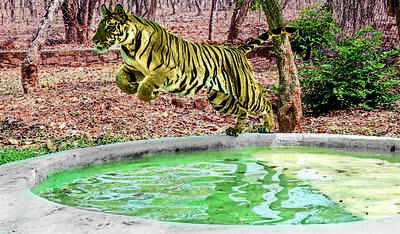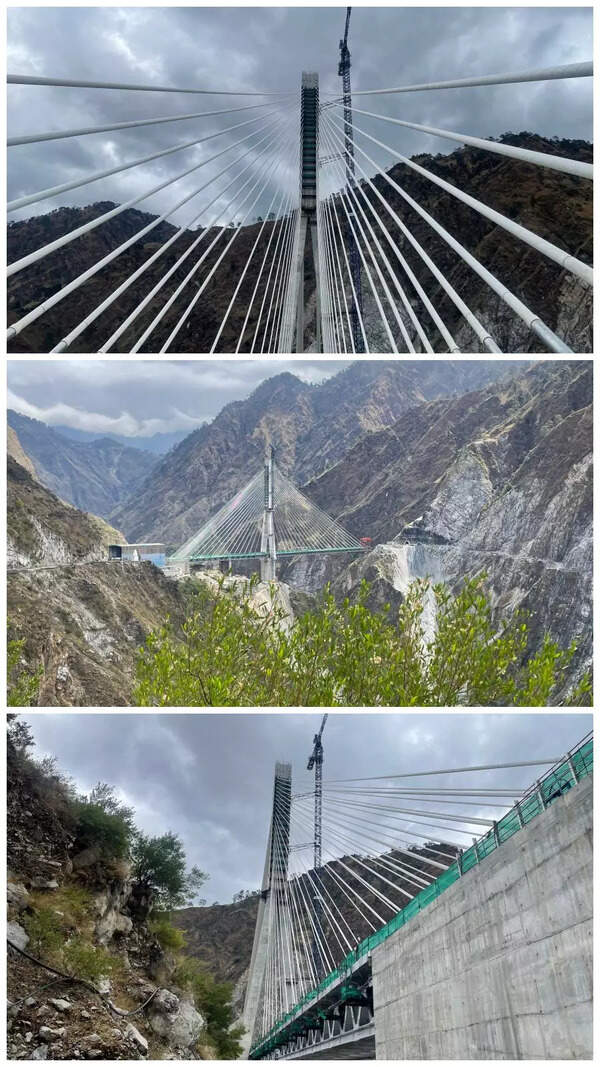- News
- India News
- Besides tourism, pay attention to conserving higher tiger numbers
Trending Topics
Besides tourism, pay attention to conserving higher tiger numbers

As the country marks 50 years of Project Tiger, we find ourselves at a critical juncture. The increasing tigers, man-animal conflict and tourism are not exactly benefiting people living near wildlife sanctuaries, and the issues need an immediate solution.
When former PM Indira Gandhi started Project Tiger, the situation was different. The big cats were on the fast track to extinction and that’s why this whole concept was envisioned and put in place.
But I feel the original plan was simply about protecting tigers by providing it a secured ecosystem. I doubt tourism, in the format we see today, was ever part of the plan.
As decades went by, the conservation policies of the government bore fruit and we clearly see the results in tiger numbers. But that increase now requires a policy rethink if we are to stay true to the spirit of tiger conservation, what Project Tiger stands for.
In Tadoba itself, the number of tigers has increased exponentially, leading to spill over into nearby areas leading to tigers coming into more frequent contact with humans.
Tiger conservation cannot happen unless people living in the periphery are equal partners in the entire process. The evolution of a tiger’s behaviour is happening faster than we would have ever imagined. Now in Chandrapur, we have the ‘urban tigers’ accustomed to living near the periphery of the jungle and human habitat.
Recently, a tiger walked all the way to Sarni, not through jungles, but through the nullahs and village periphery. That’s because the tiger was used to being near human habitat more than animals in the jungle.
This is happening because Tadoba is unable to accommodate the tiger numbers now. Almost every other day you see territorial fights between tigers, and this will only increase.
Another change in tigers is the preference of prey. In the wild, the tiger faces multiple failures before catching prey. The tiger has to learn the hard way that it should walk towards the prey against the direction of the wind, else its scent will be picked up by herbivores. There are multiple such challenges which the tiger faces and even at the end it may not get the biggest prey.
Take the example of women in very remote villages grinding masalas by hand, which takes a lot of work. But if they had access to electric grinders, do you think they would revert to hand-grinding again? Similarly, tigers have now discovered that cattle are much easier to catch, with almost 100% success rate, and are large enough for a big meal. So, we have tigers now turning into cattle lifters.
This has increased confrontation with humans, and now threatens their existence.
However, tourism is booming because tiger sighting is almost guaranteed. Unfortunately, tourism has now become tiger-focused, and in Tadoba people are shelling out huge amounts to see the tiger in the wild. But this is coming indirectly at the cost of almost 50 human lives every year, as the increasing number of big cats force them to move into human habitat.
The human reaction, as expected, is negative, and the government has no choice but start operations for capturing problem tigers.
But apart from human-animal conflict, this increase in numbers has also given rise to territorial fights between the big cats. In Tadoba, such fights have become a regular feature which unfortunately are getting promoted for tourism purposes.
This should actually be a warning for us. As tiger numbers increase, do we have a roadmap for the future of tiger conservation? I believe the answer is no. As of now there is nothing which points in that direction.
The tiger conservation policies of 50 years ago were very good, focused at solving a particular problem, which was the rapidly falling tiger numbers. Now, decades later, we have to evolve a policy keeping in mind the increasing number of tigers. Translocation is the best option for now, but we have to think what happens after 25 years when their numbers increase even more.
Our policies must have 100% implementation because even today we have to launch protests to ensure that wildlife corridors are not destroyed, and mitigation measures are put in place.
And we cannot ensure tiger conservation by ignoring the biggest stakeholders, which are the people living in the periphery.
The so-called tourism boom has not put money in the pockets of these people. When a tourist comes, a few hundred go to the local guide, while some villagers are engaged in menial jobs in nearby resorts. But guests spend up to Rs40,000 per night on a package tour, and that money is going to big businesses from the cities.
Instead, if we had promoted the homestay concept of tourism then the locals would have got the ‘actual’ money and their interest in tiger conservation would be way more.
While tiger conservation has come a long way since the inception of Project Tiger, we need to evolve our policies in line with the new ground reality of increase in big cat numbers so that our future generations can also enjoy seeing this animal in the wild.
When former PM Indira Gandhi started Project Tiger, the situation was different. The big cats were on the fast track to extinction and that’s why this whole concept was envisioned and put in place.
But I feel the original plan was simply about protecting tigers by providing it a secured ecosystem. I doubt tourism, in the format we see today, was ever part of the plan.
As decades went by, the conservation policies of the government bore fruit and we clearly see the results in tiger numbers. But that increase now requires a policy rethink if we are to stay true to the spirit of tiger conservation, what Project Tiger stands for.
In Tadoba itself, the number of tigers has increased exponentially, leading to spill over into nearby areas leading to tigers coming into more frequent contact with humans.
Tiger conservation cannot happen unless people living in the periphery are equal partners in the entire process. The evolution of a tiger’s behaviour is happening faster than we would have ever imagined. Now in Chandrapur, we have the ‘urban tigers’ accustomed to living near the periphery of the jungle and human habitat.
Recently, a tiger walked all the way to Sarni, not through jungles, but through the nullahs and village periphery. That’s because the tiger was used to being near human habitat more than animals in the jungle.
This is happening because Tadoba is unable to accommodate the tiger numbers now. Almost every other day you see territorial fights between tigers, and this will only increase.
Another change in tigers is the preference of prey. In the wild, the tiger faces multiple failures before catching prey. The tiger has to learn the hard way that it should walk towards the prey against the direction of the wind, else its scent will be picked up by herbivores. There are multiple such challenges which the tiger faces and even at the end it may not get the biggest prey.
Take the example of women in very remote villages grinding masalas by hand, which takes a lot of work. But if they had access to electric grinders, do you think they would revert to hand-grinding again? Similarly, tigers have now discovered that cattle are much easier to catch, with almost 100% success rate, and are large enough for a big meal. So, we have tigers now turning into cattle lifters.
This has increased confrontation with humans, and now threatens their existence.
However, tourism is booming because tiger sighting is almost guaranteed. Unfortunately, tourism has now become tiger-focused, and in Tadoba people are shelling out huge amounts to see the tiger in the wild. But this is coming indirectly at the cost of almost 50 human lives every year, as the increasing number of big cats force them to move into human habitat.
The human reaction, as expected, is negative, and the government has no choice but start operations for capturing problem tigers.
But apart from human-animal conflict, this increase in numbers has also given rise to territorial fights between the big cats. In Tadoba, such fights have become a regular feature which unfortunately are getting promoted for tourism purposes.
This should actually be a warning for us. As tiger numbers increase, do we have a roadmap for the future of tiger conservation? I believe the answer is no. As of now there is nothing which points in that direction.
The tiger conservation policies of 50 years ago were very good, focused at solving a particular problem, which was the rapidly falling tiger numbers. Now, decades later, we have to evolve a policy keeping in mind the increasing number of tigers. Translocation is the best option for now, but we have to think what happens after 25 years when their numbers increase even more.
Our policies must have 100% implementation because even today we have to launch protests to ensure that wildlife corridors are not destroyed, and mitigation measures are put in place.
And we cannot ensure tiger conservation by ignoring the biggest stakeholders, which are the people living in the periphery.
The so-called tourism boom has not put money in the pockets of these people. When a tourist comes, a few hundred go to the local guide, while some villagers are engaged in menial jobs in nearby resorts. But guests spend up to Rs40,000 per night on a package tour, and that money is going to big businesses from the cities.
Instead, if we had promoted the homestay concept of tourism then the locals would have got the ‘actual’ money and their interest in tiger conservation would be way more.
While tiger conservation has come a long way since the inception of Project Tiger, we need to evolve our policies in line with the new ground reality of increase in big cat numbers so that our future generations can also enjoy seeing this animal in the wild.
Start a Conversation
FOLLOW US ON SOCIAL MEDIA
FacebookTwitterInstagramKOO APPYOUTUBE










